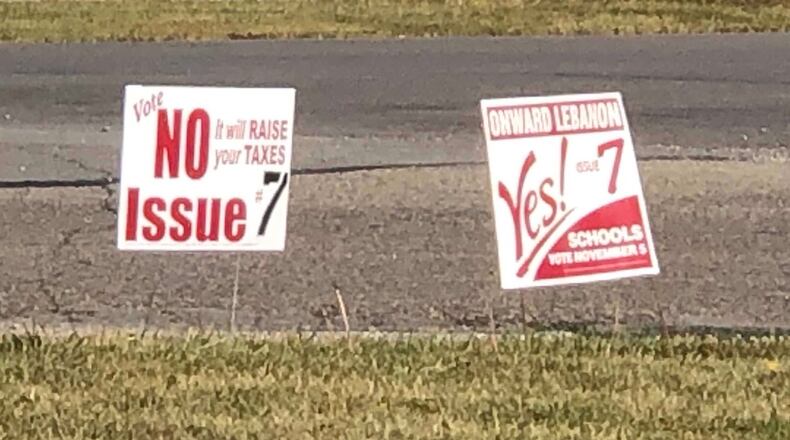Residents rejected a similar tax levy in May by a 56-44 ratio, with very low turnout — around 20 percent of registered voters participated. In response, Lebanon schools made $1.46 million in annual recurring spending cuts in June, eliminating 14 positions and reducing curriculum, technology and transportation expenses.
RELATED: Lebanon holds series of levy Q&A meetings
The upcoming vote is on a four-year, 4.99-mill levy to pay for day-to-day operating expenses. If passed, it would raise $5 million per year and would cost the owner of a $100,000 home an extra $175 per year.
This week, Superintendent Todd Yohey released a detailed breakdown of further cuts planned if the Nov. 5 levy is rejected. They include 16 layoffs in January (mainly aides and custodians), then another 30 job cuts in summer 2020, including 13 teachers.
The district would also cut busing to state minimums – no high school busing, and K-8 busing only for those who live more than two miles from school. And there would be a massive increase in sports pay-to-play fees, likely rising to $700 or $800 per sport. The cuts would create more than $15 million in savings over the next four years.
Yohey said the community’s desires are the same as in other school districts – effective education, transportation for all students, good safety and security and getting maximum bang from every buck in the budget. But he said Lebanon’s spending per pupil is already among the lowest in the state.
MAY STORY: Lebanon schools plan round of cuts after levy rejection
“There aren’t a lot of extras that you may see in other school districts. And that’s a pro and a con,” Yohey said. “If you’re just talking about finances, a low cost per pupil is a very good thing. But if you’re talking about educational resources and staffing and the ability to offer a range of elective courses, then it’s not so great.”
The Ohio Department of Education’s most recent District Profile Report (or Cupp Report) ranks Lebanon’s $9,254 spending per pupil as 571st of the 607 Ohio school districts, or in the bottom 7 percent.
But some residents have said that by itself should not be a reason to increase spending. Lebanon saw its overall state report card grade for 2018-19 rise from a “C” to a “B” with its student progress grade jumping from a “D” to a “B.”
The community has had a very active debate over the levy – Wednesday night’s Facebook Live session with district leaders had more than 2,700 views and 150 comments 20 hours later. Some residents have asked, if things are going well, why pay more?
MAY STORY: Superintendent reacts to levy result
“This levy is about allowing us to continue doing that,” Yohey said. “This levy is not going to allow us to hire additional teachers, or add programming, or purchase extra instructional materials and technology. … It’s really just to allow us to continue what we’re doing right now and prevent us from having to make those cuts.”
Lebanon schools’ last levy that increased taxes came in 2011. Their most recent five-year forecast shows that after years of operating at a smaller and smaller annual surplus as expenses rose, they finished in the red for 2018-19.
Some of the cost increases have little to do with educating kids. Yohey said after several years of single-digit percentage increases, the district’s health care costs will see a double-digit rise next year. Lebanon has tried to offset increases via efficiencies in staffing, busing and other areas.
Lebanon schools began this school year with about $21 million in the bank, or 36 percent of a year’s expenses. That’s a larger percentage cushion than Springboro, Franklin or Mason schools carried into this year.
APRIL STORY: School levies put focus on state funding fight
Yohey suggested that last school year’s deficit spending is a key change, after the district stayed in the black for years after the 2011 tax increase passed.
Residents’ online comments about the levy varied widely. Some parents in favor of the levy worried that if it was rejected again, their children’s existing course options would be removed, and that rising class sizes would affect educational quality.
Opponents to the levy asked for sports and extracurriculars to take heavier cuts, asked why Lebanon couldn’t replicate Springboro’s extremely low spending, were upset about previous spending on new school buildings, or were simply against tax increases of any kind.
Asked if a school income tax was a viable option to this levy or layoffs, Yohey cited timing and community unfamiliarity with that model as drawbacks. Asked whether pay cuts were an option rather than eliminating staff, Yohey said that was unlikely, citing the three-year stretch from 2011-14 when teachers already took a full pay freeze and administrators took a 2 percent decrease.
RELATED: West Carrollton seeks bond levy to build new schools
The school district and levy committee have tried to increase awareness of the levy after May’s low voter turnout. They’ve sent mailers, used their websites, social media and local access television, and held numerous public question-answer sessions. Levy signs dot the community – both pro-levy and anti-levy.
Yohey said if voters pass the levy, some of the staff who were cut over the summer may be re-hired. If voters reject this levy, any decision about going back on the ballot next spring will be made by the school board, which could also look different after the Nov. 5 election.
But Yohey said if the levy is rejected, he will not recommend asking voters again in March.
“That’s democracy. That’s the community saying we’re OK with those cuts. There’s a point where you have to accept that,” he said.
RELATED: Centerville schools seek first levy increase in six years
About the Author

